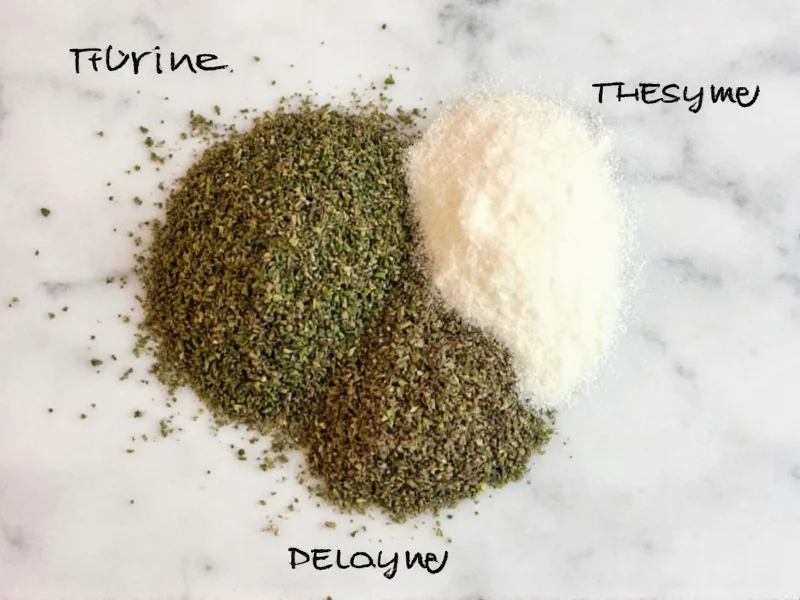When converting fresh herbs to dried in your cooking, understanding the precise measurements ensures your dishes maintain balanced flavor profiles. The notation "1 1 2 tsp" commonly appears in recipes and refers to 1 and 1/2 teaspoons (1.5 tsp) of fresh thyme. This measurement conversion is essential knowledge for home cooks and professional chefs alike who need to adapt recipes based on available ingredients.
The Science Behind Herb Conversion Ratios
Herb dehydration removes moisture content while concentrating flavor compounds. Fresh thyme contains approximately 85% water, which evaporates during drying, leaving behind intensified essential oils and aromatic compounds. This concentration effect creates the standard 3:1 conversion ratio between fresh and dried herbs that culinary professionals rely on.
Thyme specifically follows this ratio consistently because its delicate flavor compounds respond predictably to dehydration. Unlike some herbs that may vary in potency when dried (like basil or cilantro), thyme maintains reliable concentration levels, making conversion calculations straightforward for recipe adaptation.
Complete Fresh Thyme to Dried Thyme Conversion Chart
| Fresh Thyme | Dried Thyme Equivalent | Common Recipe Application |
|---|---|---|
| 1/4 teaspoon | 1/12 teaspoon | Delicate sauces, finishing touches |
| 1/2 teaspoon | 1/6 teaspoon | Salad dressings, light marinades |
| 1 teaspoon | 1/3 teaspoon | Standard seasoning for 4 servings |
| 1 1/2 teaspoons | 1/2 teaspoon | Robust dishes, stews, braises |
| 1 tablespoon | 1 teaspoon | Large batch cooking, preserving |
Practical Application in Recipe Development
When substituting dried thyme for fresh in your cooking, consider these professional techniques:
- Timing matters: Add dried thyme early in the cooking process to allow rehydration and flavor diffusion, while fresh thyme works best added in the final 10-15 minutes to preserve volatile oils
- Texture considerations: Dried thyme leaves become more noticeable in texture when not properly incorporated, so consider rubbing between your fingers before adding to dishes
- Flavor development: Dried thyme develops more earthy, slightly camphorous notes compared to fresh thyme's brighter, grassier profile
- Storage impact: Dried thyme loses potency over time—replace your supply every 6-12 months for optimal flavor in conversions
Avoiding Common Conversion Mistakes
Many home cooks make critical errors when converting fresh thyme measurements to dried equivalents. The most frequent mistake involves misinterpreting the "1 1 2" notation as separate measurements rather than recognizing it as 1 and 1/2 teaspoons. This misunderstanding leads to triple the intended seasoning, creating overpowering results.
Another common error occurs when cooks apply the same conversion ratio to all herbs without considering individual characteristics. While thyme reliably follows the 3:1 ratio, some herbs like rosemary maintain even stronger concentration (4:1), while others like basil lose significant flavor during drying (2:1).
For precise measurement of small dried herb quantities like 1/2 teaspoon, use proper measuring spoons rather than estimating. The difference between 1/2 teaspoon and 5/8 teaspoon represents a 25% increase in seasoning that can dramatically alter your dish's flavor balance.
Professional Chef Recommendations
Experienced chefs recommend these best practices when working with thyme conversions:
- Always measure dried herbs with precision tools—digital scales provide the most accurate results for critical conversions like 1 1/2 tsp fresh to dried thyme
- When in doubt about herb potency, start with 25% less than the calculated conversion and adjust to taste
- For long-cooking dishes, reduce dried herb quantities by 10-15% as extended heat exposure intensifies flavors
- Store dried thyme in airtight containers away from light and heat to maintain consistent potency for reliable conversions
Understanding the relationship between fresh and dried thyme measurements transforms your cooking precision. The conversion from 1 1/2 teaspoons fresh thyme to 1/2 teaspoon dried thyme represents more than just a mathematical calculation—it's a fundamental culinary technique that affects flavor development, texture, and overall dish balance. By mastering this conversion and understanding the principles behind it, you'll consistently achieve professional-quality results regardless of which form of thyme you have available.











 浙公网安备
33010002000092号
浙公网安备
33010002000092号 浙B2-20120091-4
浙B2-20120091-4